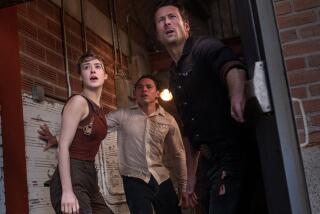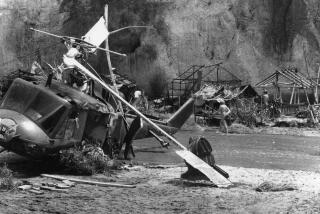‘Twilight’ Camera Operator Cites Dangers
- Share via
A camera operator aboard the ill-fated helicopter on the “Twilight Zone” film set testified Tuesday that the special effects explosives that knocked the craft out of the sky felt “like a tidal wave . . . hit(ting) the chopper.”
Roger Smith, 51, later told reporters outside the courtroom that the 1982 accident that killed actor Vic Morrow and two child actors occurred because of a lack of communications between film director John Landis and other crew members.
“Anytime you get helicopters and explosions . . . you (have to) have tremendous communication with one another,” said Smith, who testified that he suffered minor back and neck injuries in the accident. “If you don’t have the communication where you explain to everyone what is going on, what the shot is, no one can evaluate the safety points or suggest better ways of doing it.”
Opinion Ruled Out
However, Los Angeles Superior Court Judge Roger W. Boren ruled that Smith, who has worked in the movie industry for more than 25 years, could not directly express such opinions to the jury.
Landis, helicopter pilot Dorcey Wingo and three associates are on trial for involuntary manslaughter stemming from the deaths of the three actors during the filming of a grandiose Vietnam battle scene. The three were killed when the helicopter, crippled by special effects mortars, plummeted from the sky and crashed onto them.
Smith, who testified for the entire day, told jurors that problems with the special effects first occurred in a shot filmed about three hours before the fatal accident.
At that time, Smith said, the craft was struck by flames and water from special effects mortars shot off from below, obscuring Wingo’s vision, singeing his face and also resulting in the pilot muttering obscenities.
Smith, who operated his camera while dangling from the side of the helicopter, said he was never told before the filming of the earlier scene that the explosives would be ignited.
Talked to Colleagues
Afterward, Smith said, he conferred with Wingo and co-defendant Dan Allingham, who was also aboard the helicopter, about their mutual concerns.
“I told him (Allingham) I would not go up and fly and shoot again with the same experience I had in the earlier shot,” Smith testified.
Allingham, the film’s unit production manager, then went to discuss the matter with the director.
When Allingham returned, “he said that he had talked to Landis . . . he told me there was nothing to be concerned of because we would be flying over the water filming Vic and the two kids,” Smith said.
However, the helicopter, hovering near the shoreline of a mock Vietnam village, was struck by the fireball of an explosive that had been placed under a hut-like structure and spun out of control.
‘Like a Tidal Wave’
“I experienced vibrations and concussion of the chopper,” Smith said, “just like a tidal wave had hit the chopper.”
Deputy Dist. Atty. Lea Purwin D’Agostino termed Smith’s testimony crucial because it showed that in spite of the earlier problems, the final scene was filmed three hours later--with the two child actors, along with Morrow, included.
Defense attorneys maintain that planning for the final scene was adequate since Landis held a brief rehearsal 20 minutes before the filming and had also met with camera operators the night before the accident.
Smith, who also testified at pretrial hearings, told reporters that he believes he was blacklisted for two years from working by major film studios because of his frank statements about the case. He said he is now working again on commercials and television shows.
“People were a little worried that we were speaking out against our industry,” Smith asserted. “But (they eventually realized) we were speaking out against injustice. . . . We wanted to see these accidents ended.”
More to Read
Sign up for Essential California
The most important California stories and recommendations in your inbox every morning.
You may occasionally receive promotional content from the Los Angeles Times.










